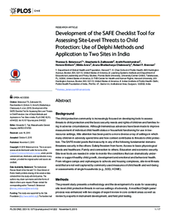Although tools for measurement of individual child health status or household functioning in low-resource settings have greatly improved, little attention has been paid to the measurement of site-level threats to child protection. As opposed to a tool that assesses an index child or a single household, a site-based tool is helpful in understanding “interconnected domains of child protection and offers a more comprehensive, holistic assessment of the conditions facing many children in a particular setting.” Thus, this study in India sought to develop the SAFE Checklist in order to assess site-level threats to child protection among children and families living in settings of adversity. The SAFE Checklist was developed based on the SAFE Model, a rights-based holistic model for child security that examines four core domains of children’s basic security needs and rights: Safety/freedom from harm; access to basic physiological needs and healthcare; family and connection to others; and education and economic security. The tool was field tested in two diverse sites in India (a construction site and a railway station) and the results demonstrated that the SAFE Checklist is a sensitive tool that captured the differences between the two sites from the standpoint of core child protection issues.

